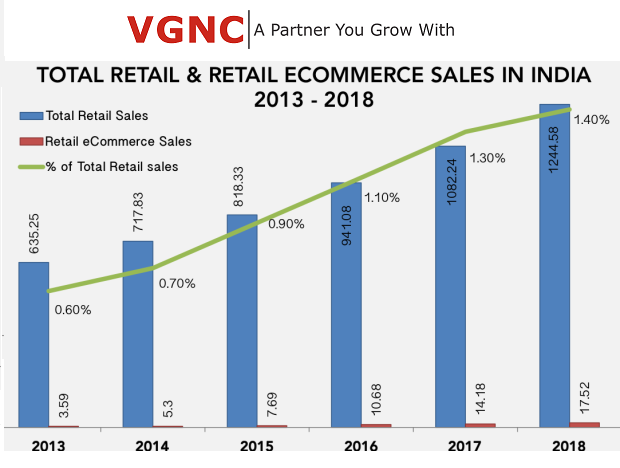Exclusive Overview of Indian Retail in 2017, what to expect in 2018
India, with
the shared category of 55 percent, was
top sourcing destination in 2016-17. For all the retail giants from across the
world, the untapped major chunk of themiddle
class is an attracting force that drives them to India. Recently, there
have been many emerging possibilities for the retail sector. With new
businessmen entering the industry, theretail
sector is expected to grow rapidly in coming years.
The Indian
retail sector is already witnessing growth at an accelerated rate. This growth
is the outcome of retail development, not only in major metros and cities but
also in Tier-II and Tier-III cities. As most of India’s population is young and
working, the purchasing power of Indian consumers is growing.
Growth in
Retail Sector
·
India will gain from the latest FDI policy in retail.
·
Indian retail is attracting investors from across the globe.
·
The confidence of investors in India’s retail economy has grown. This
has been proved when India ranked 8th in FDI Confidence Index.
·
Increase in income, availability of credit and change in lifestyle major
contributors in Indian retail industry.
India’s retail industry is, undoubtingly, one of the fastest growing retail industry in
the world. Accounting for 10 percent of the country’s GDP, it is hovering
over all industries not only in its contribution to GDP but also in employment.
This high growth potential is attracting investors from all around the world.
The
availability of credit has enhanced the purchasing power of the consumers. This
increase in purchasing power has supported the sale of higher value items and
also encouraged repeated purchases. The consumer mindset in buying has shown a clear shift with many of them making well-informed buying decisions. Consumers are
more ready to experiment and are willing to buy those products that they have
never used before.
The
expansion in the purchasing power of middle class has led to an increase in the purchases of luxury products and
also facilitated brand consciousness. While the increase
in discretionary income and change in lifestyle have been significant growth
drivers of Indian retail sector, GST has helped in simplifying the tax
structure. Thus, leading to better cash flows, supply chain structure,
profitability,and pricing.
Future Possibilities
·
The rural market has immense growth potential and needs to tapped
·
Private label is experiencing
increased level of activity and has tremendous opportunity
·
Large retail players are attracted towards the price competitiveness of
Indian retail market
·
International retailers are increasing sourcing from India
If tapped
with theright set of products and
pricing, there are high growth
possibilities in arural marketin India. In
recent years, there has been an increased investment in infrastructure. This
has helped in building connectivity which has extended the reach of retailers
to therural market.
The organised Indian retail sector has begun to
experience an increased level of activity in private label space. The share of
private label in just 6 percent in comparison to 19 percent in theUS and 39 percent in theUK. Therefore, there are many opportunities for homegrown labels. Many international retailers
are increasing sourcing and moving from third party purchasing office to having
their own offices that are wholly owned and managed by them.
Key
Initiatives
Ø
100%
FDI under government approval route for trading for food products manufactured
and/or produced in India
Ø
Minimum
investment cap is USD 100 million
Ø
The
government reserves the right to procure a certain amount of food grains to
ensure the Public Distribution System (PDS) and Food Security System (FSS).
This will enhance consumer security.
Key Points
1. The online retail industry is growing
at an accelerated rate of 12 percent with the revenue reaching USD 14.5
billion.
2. The estimated organised retail penetration share would reach 13 percent in 2019.
3. The unorganised
retail penetration will hold amajor share
of 87 percent in 2019.
4. FMCG market expected to reach USD
103.7 billion by 2020.
Challenges of
Retail Industry
The
diversity in the state policies and local influences has become a hindrance for
the retail to expand in all aspects. The non-availability
of skilled labour, discounts from online
retailers and the high cost of real
estate are some of the challenges in the rural market.
Indian
retail industry is on a growing track. And in comparison to other industries,
it is recording the fastest growth.
India’s growth into a developed country depends on the growth of its retail just like most of the developed countries
today. India is a dynamic place that is being targeted by many international
brands to capitalise the growing
consumption pattern. With better government policies coming into play, the
future of Indian retail looks promising in 2018.
Visit us at: http://www.vgnc.in/
or contact us : 9810666554, 7668010101
Email : info@vgnc.in , vgnc@vgnc.in
#Tax #Taxpayers #teamwork #incometax #InternalAudit #assets #BusinessAdvisoryServices #SupplyChainAudit #InventoryAudit #DirectIndirectTax #LegalServices #retail #bestcaservices
#businessconsultant #businessadvisor #audit #assurance #vgncbusiness #caconsultancy #VGNC #pharmacy
#businessconsultant #businessadvisor #audit #assurance #vgncbusiness #caconsultancy #VGNC #pharmacy





Comments
Post a Comment